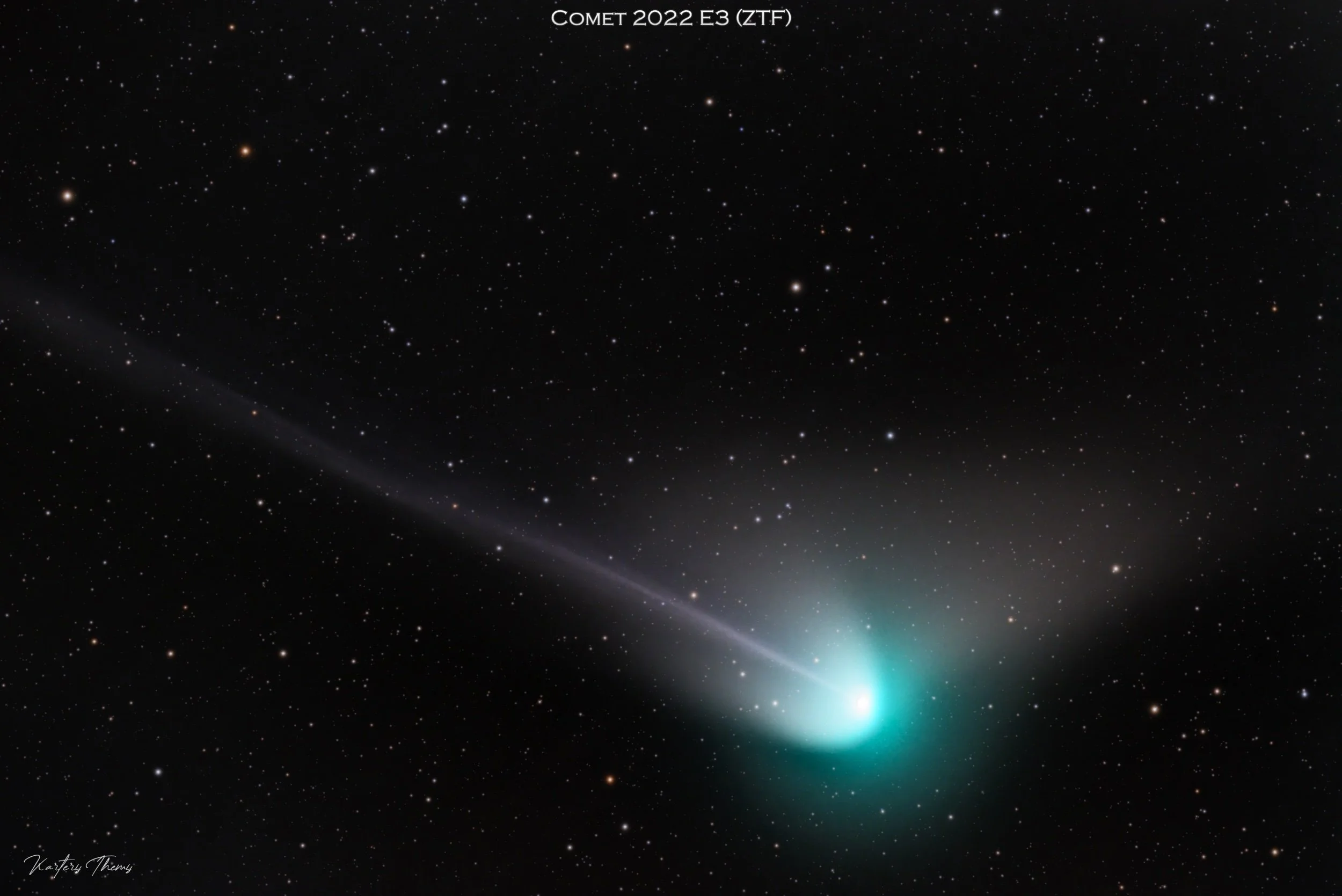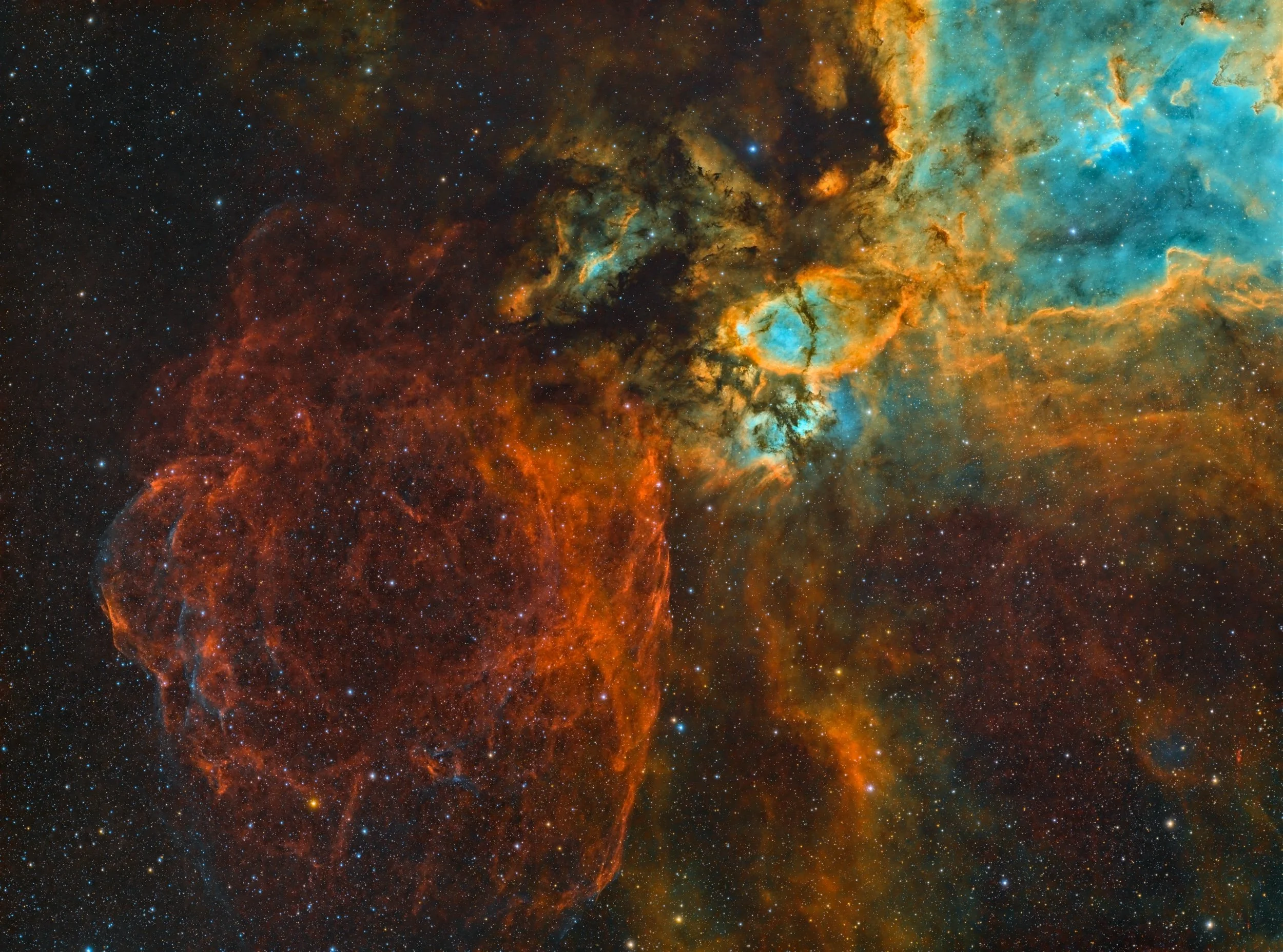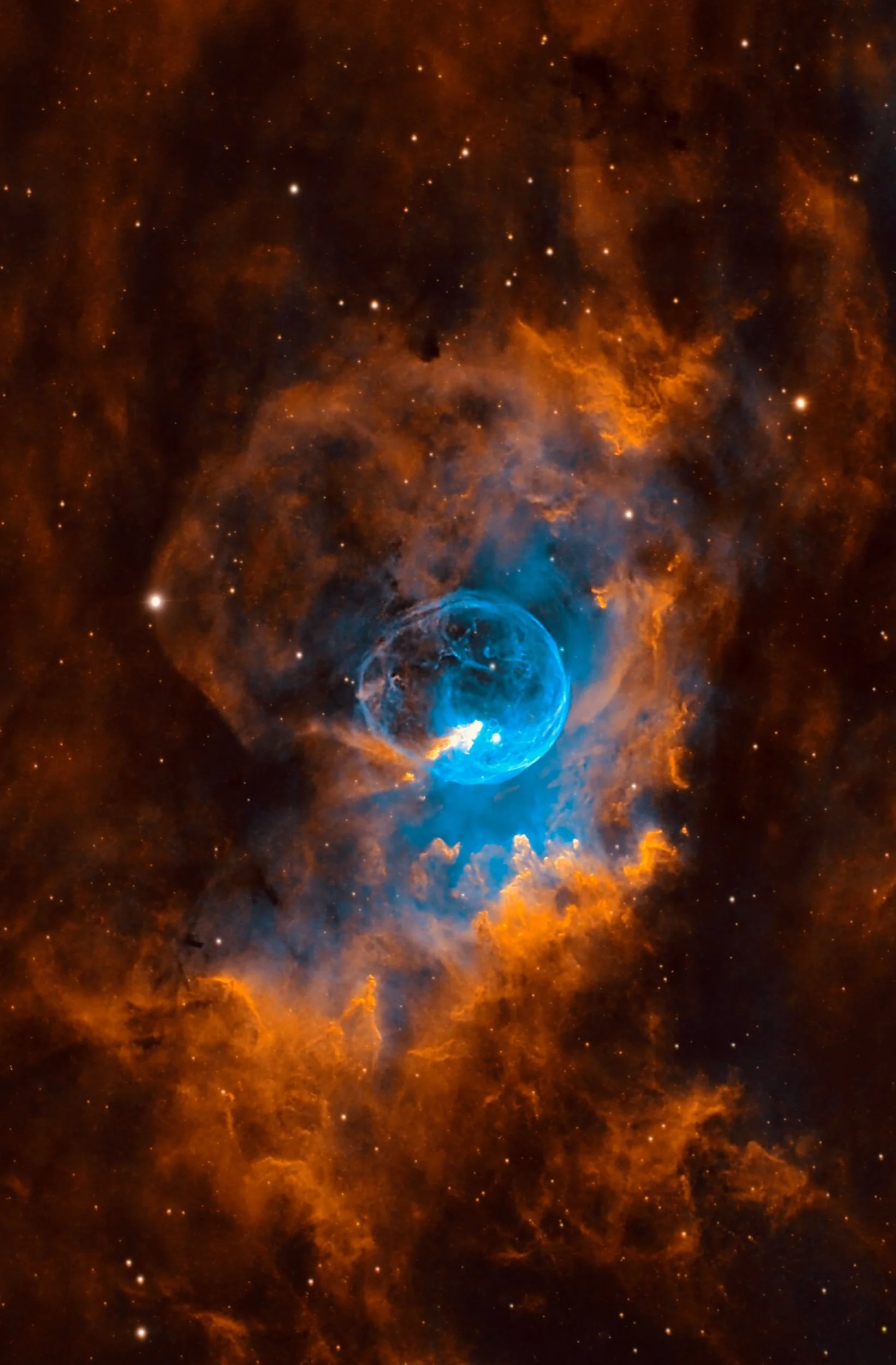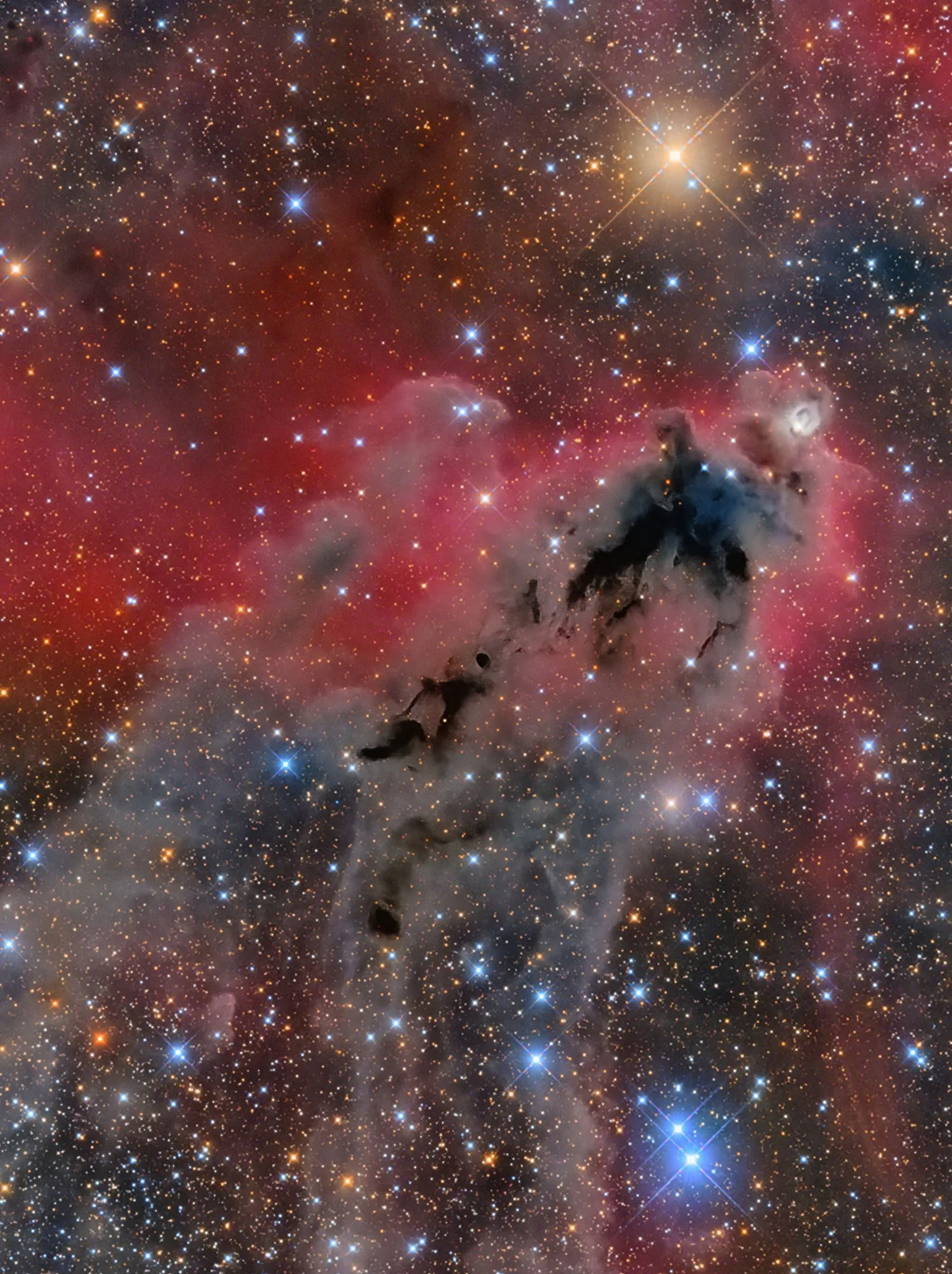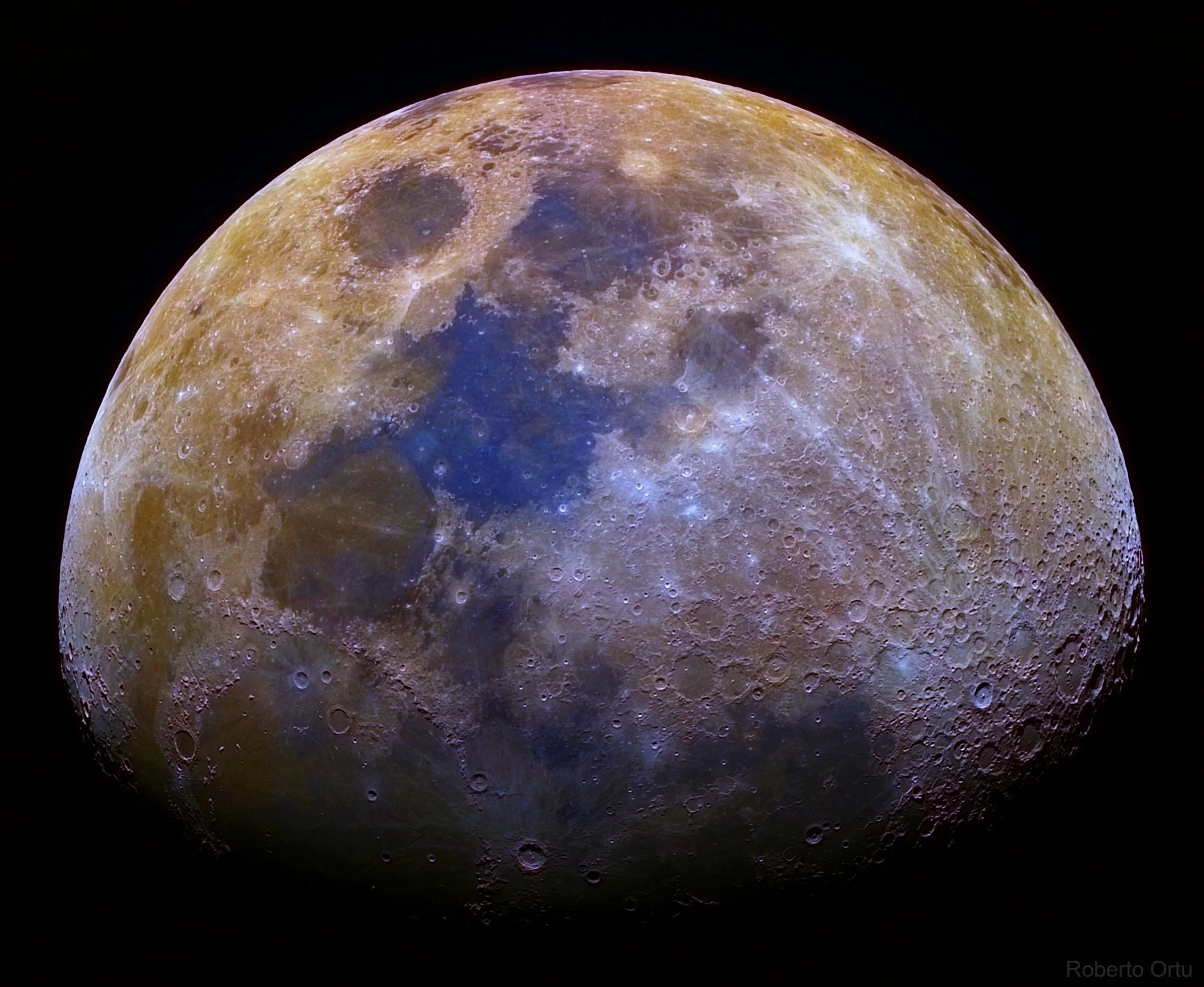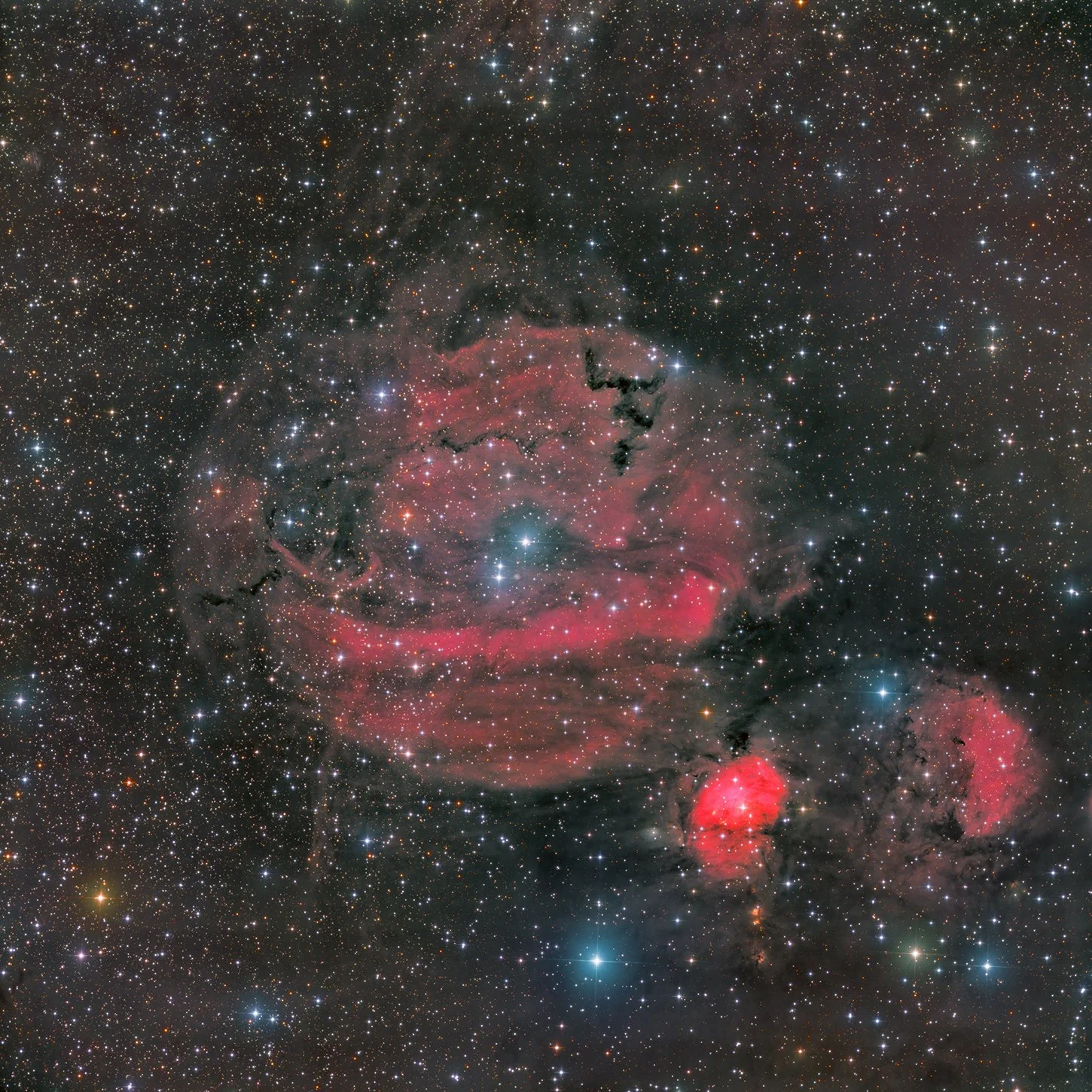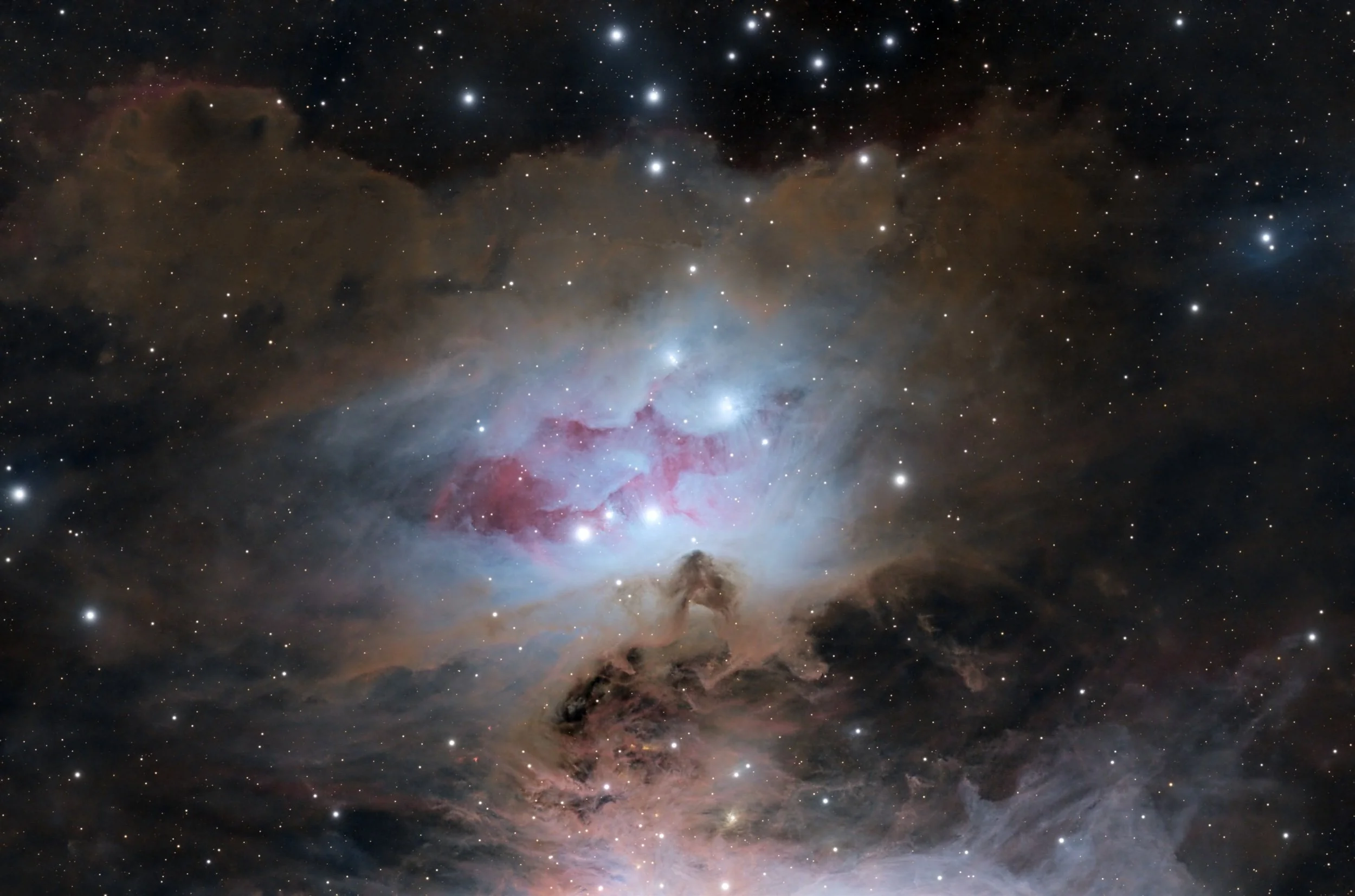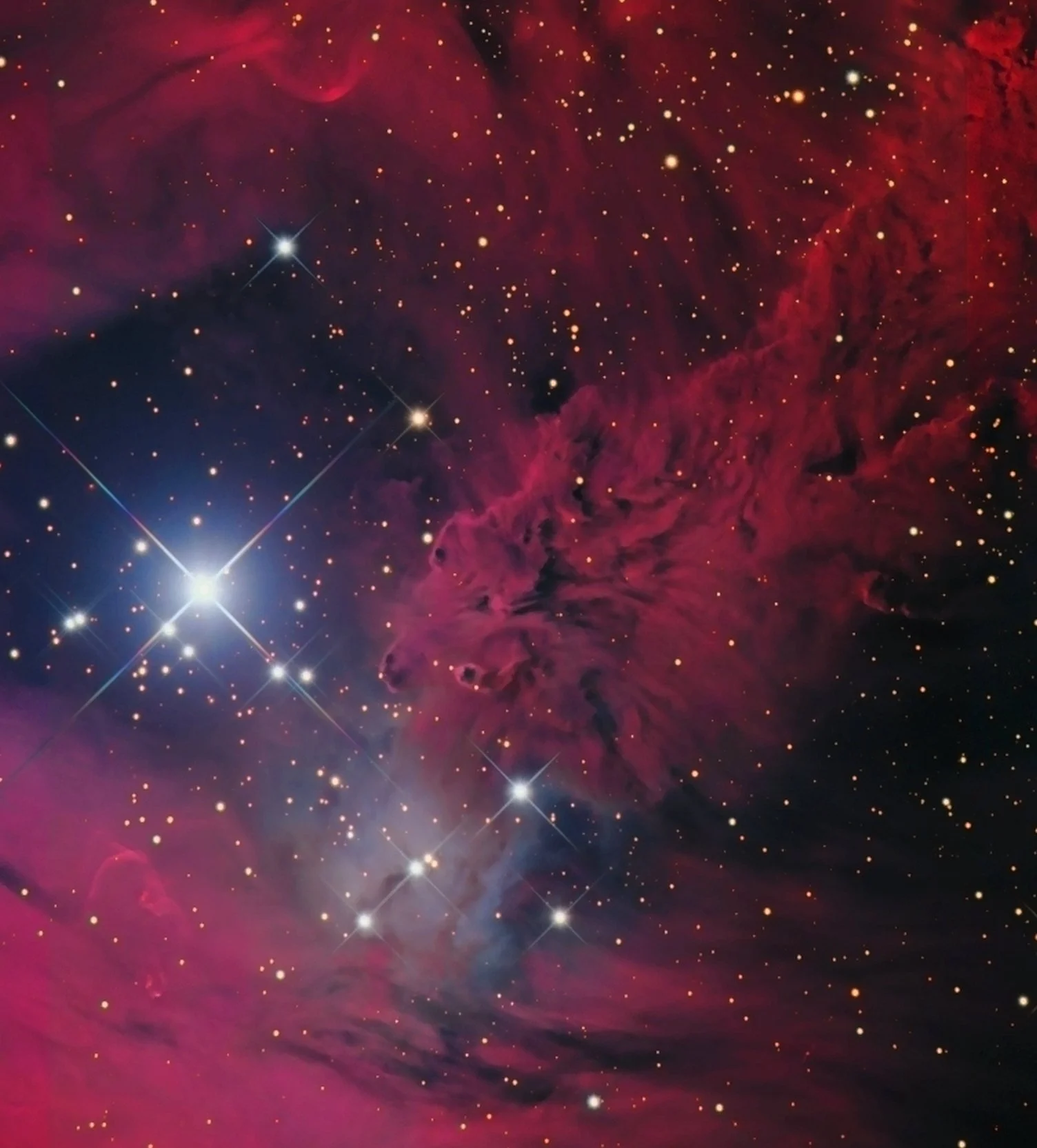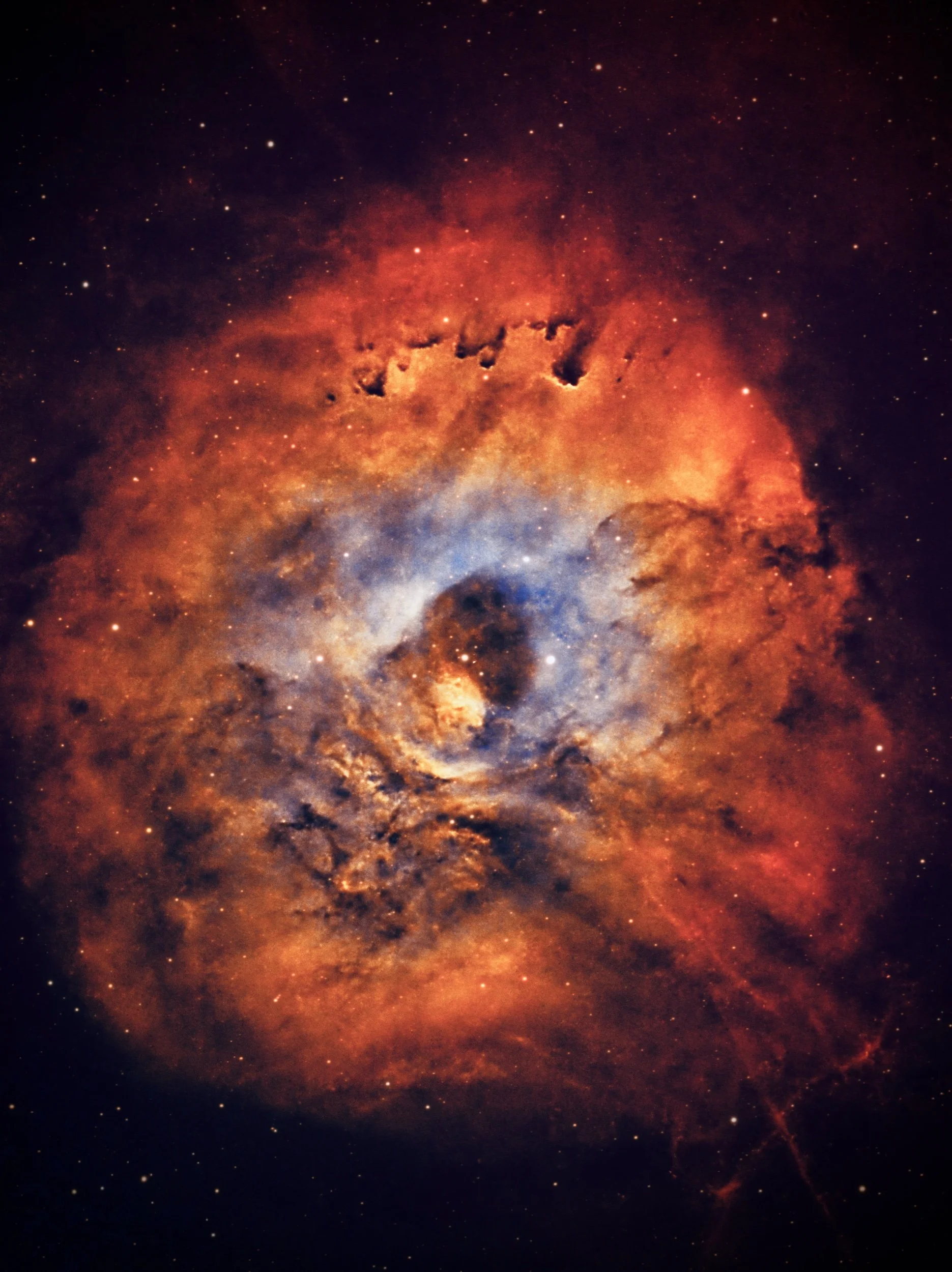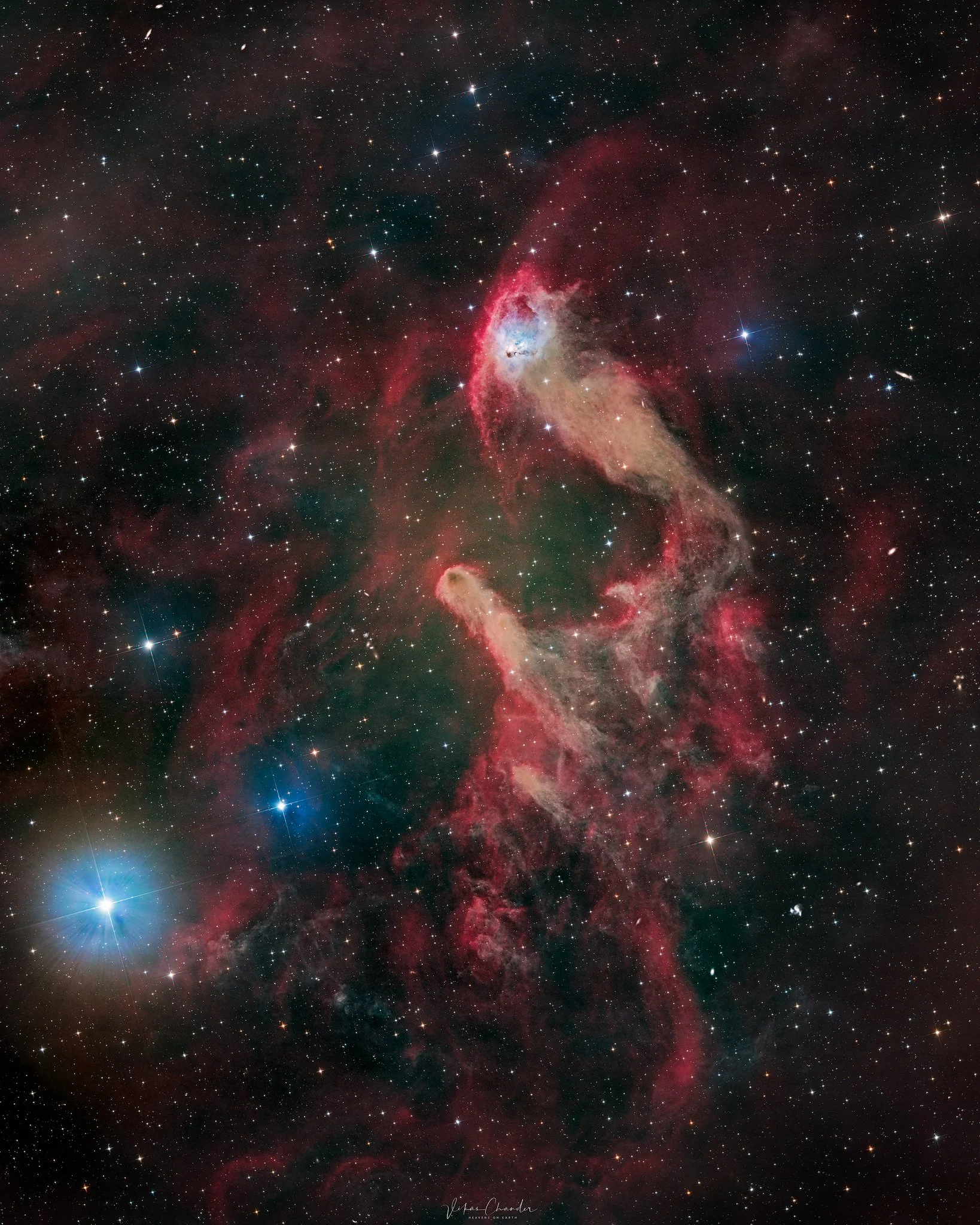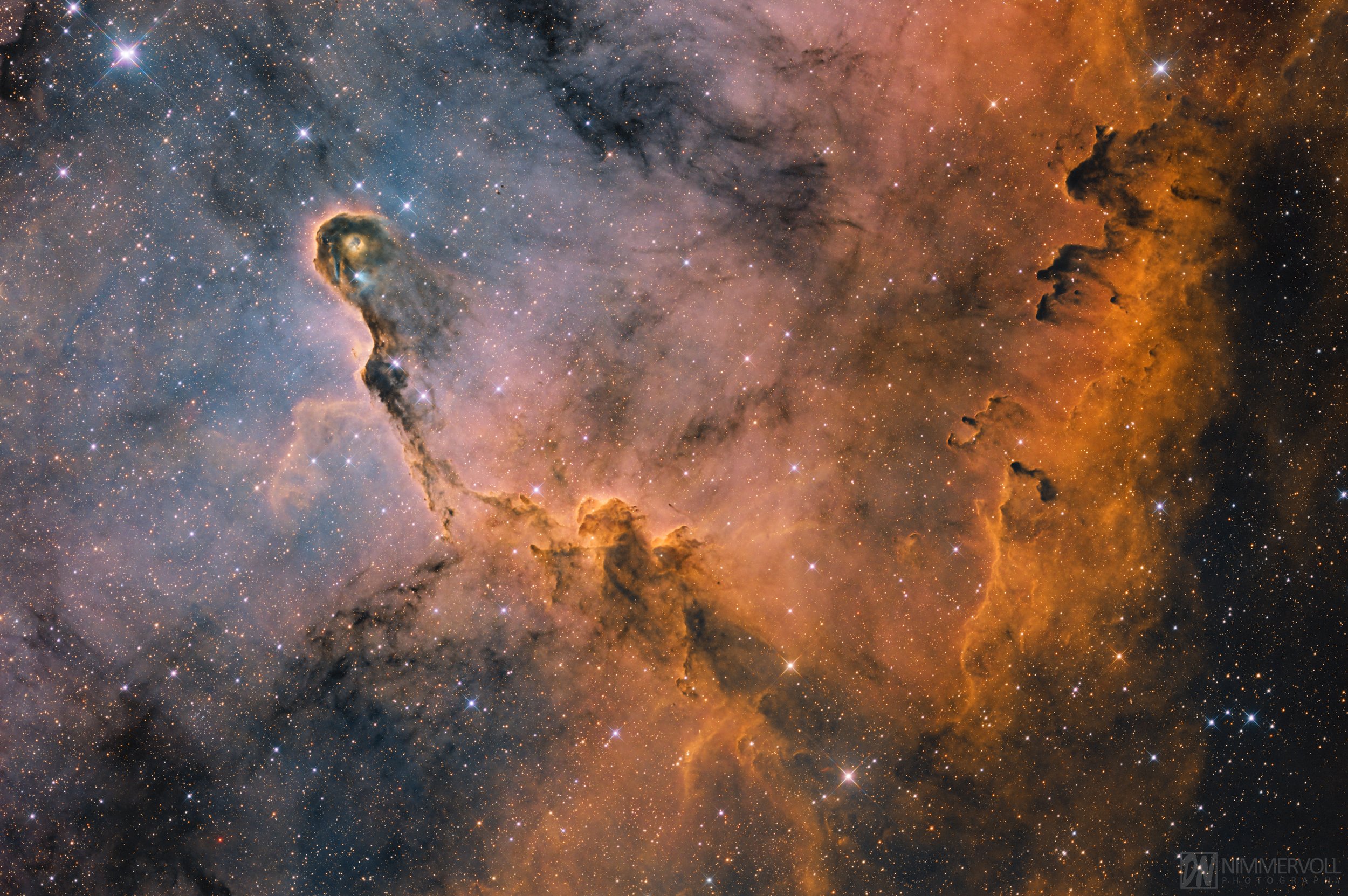
AAPOD2 Image Archives
C/2022 e3 ztf
Image Description and Details : First try with the new Pegasus Astro NYX-101 mount and my first astrophotography on a comet.
Imaging Telescope: Sky-Watcher Esprit 100ED
Imaging Cameras: QHYCCD QHY268 Pro M
Mounts: Pegasus Astro NYX-101
Filters: Baader Blue (B-CCD) 36 mm · Baader Green (G-CCD) 36 mm · Baader Red (R-CCD) 36 mm · Baader UV/IR Cut / Luminance 36 mm
Accessories: Intel NUC 10 · Pegasus Astro FlatMaster 150 · Pegasus Astro FocusCube2 · Pegasus Astro Ultimate Powerbox 2 · QHYCCD PoleMaster · QHYCCD QHYCFW3-M-US · QHYCCD QHYOAG-M
Software: Adobe Photoshop · Open PHD Guiding Project PHD2 · Pleiades Astrophoto PixInsight · Stefan Berg Nighttime Imaging 'N' Astronomy (N.I.N.A. / NINA)
Bortle:4
Exposures: All fits 60sec-Lum~27min Red~25min Green~25min Blue 25min.
Calibration Frames: Flats 10 - Darks 15 - Dark Flats 10
Copyright: Karteris Themis
IC 1805 and accompanied by this magnificent HB3 supernova remnant.
image details:
Ts optics 62/297 quintuplet
Ioptron GEM45
ZW0 asi 1600 mm pro
Pixinsight and photoshop
Antlia 3nm Narrowband H-alpha 1.25": 265×300″(22h 5′) (gain: 139.00) f/4.8 -20°C bin 1×1
Antlia 3nm Narrowband Oxygen III 1.25": 102×600″(17h) (gain: 139.00) f/4.8 -20°C bin 1×1
Antlia 3nm Narrowband Sulfur II 1.25": 102×600″(17h) (gain: 139.00) f/4.8 -20°C bin 1×1
Astronomik Deep-Sky Blue 1.25": 50×120″(1h 40′) (gain: 0.00) f/4.8 -20°C bin 1×1
Astronomik Deep-Sky Green 1.25": 50×120″(1h 40′) (gain: 0.00) f/4.8 -20°C bin 1×1
Astronomik Deep-Sky Red 1.25": 50×120″(1h 40′) (gain: 0.00) f/4.8 -20°C bin 1×1
Intégration:
61h 5′
Copyright: PUIG Nicolas
Vela Supernova Remnant
Image Description and Details : Vela Supernova Remnant
This is one of my favourite regions.
7 hours of 180s and 300s subs taken over 3 nights. (Shorter subs on a windy night).
Taken from my back yard here in Western Australia, Bortle 2 skies.
Equipment: Askar ACL200 with quad band filter, Skywatcher EQ6-R mount, ZWO ASI294MC-pro camera. ZWO ASIAIR-plus
Processed with Astropixel processor and Pixinsight
Copyright: Copyright: Michelle Bennett
Gum 37 / RCW 54c & NGC 3572 Stars Cluster
Image Description and Details : The target features glowing gas and dark dust clouds alongside the young stars of NGC 3572, a beautiful emission nebula and a star cluster located in the southern sky in the constellation Carina.
Image acquisition information:
Location: El Sauce, Chile
Scope: CDK 24" (F/6.8)
Camera: QHY 600m
Sii, Ha, Oiii, respectively each 600s
Intégration time : 5h
Copyright: Aygen Erkaslan / Telescope Live
SH2-162 - The Bubble Nebula
Image Description and Details : SH2-162 - The Bubble Nebula.
An H II region emission nebula in the constellation Cassiopeia, about 11,000 light years away. The "bubble" is created by the stellar wind from a massive hot, 8.7 magnitude young central star, SAO 20575.
Celestron 14” Edge HD with .7x reducer at F/8
Celestron OAG and a ZWO 174mm guide camera
Ioptron CEM 120 mount
ZWO 2600MM Pro cooled to -10° / gain 100.
ZWO ASIAIR pro+
ZWO EAF focuser
Chroma 3nm filters with ZWO 7x36mm EFW
Processed in Pixinsight.
Shot from my backyard, bortle 8.
Sii - 5 min subs x 46 = 4 hrs.
Ha - 5 min subs x 58 = 5 hrs.
Oiii - 5 min subs x 43 = 4 hrs.
Total integration time = 13 hrs.
Copyright: Richard McInnis
Heckathorn-Fesen-Gull 1 (HFG1) aka PK 136+05
Image Description and Details : HFG-1 was discoverd in 1982 by Heckathorn, Fesen and Gull. Its central star is actually a binary star system, V664 Cas (magnitude 14) that is moving through our galaxy. V664 Cas consists of a white dwarf star and a large red giant, rotating around their centre of gravity every 14 hours. As HFG 1 moves through the ISM a bowshock is produced in front of it as well as a red trail of gas in its wake. Outer diameter about 15 arcmin.
HOO palette
82h Ha
36h Oiii
and some RGB for the stars.
Equipment:
Celestron EdgeHD14"
ZWO asi6200mm
Chroma 3nm
10Micron GM3000 HPSII
Scopedome 3M
Imaged from E-eye, Spain
Copyright: Sven Eklund
Dark Pillars in Orion
Image Description and Details : LDN 1622, also referred to as the Boogeyman Nebula, is a dark nebula that appears against the glowing Hydrogen of Barnard’s Loop in the constellation of Orion. However, LDN 1622 is thought to be much closer than Orion's more famous nebulae, perhaps only 500 light-years away. Its foreboding appearance lends this dark nebula its popular name, the Boogeyman Nebula.
Data:
210x120” (7h), gain 120, -20°
Darks, Flats, Dark Flats
Bortle 3 (21.86)
Gear:
Sharpstar 13028HNT f2.8
iOptron GEM45
ZWO ASI294MC Pro
ZWO ASiair Plus
ZWO ASI174MM Mini (guide)
ZWO OAG-L
ZWO EAF
Post:
DeepSkyStacker
PixInsight
RC-Astro BXT, NXT, SXT
Adobe Photoshop
Copyright: Joshua Carter
A colorful Moon mosaic
Image Description and Details : This is my lunar mosaic of the waxing gibbous mineral Moon (9.50 days old).
Technical data:
Celestron 114/910 Newton
Planetary camera QHY5L-II-C
Filter UV IR cut
Software: Sharpcap 3.2, Autostakkert! 3.1.4, Astrosurface T5-TITANIA, Autostitch, GIMP
Location: Cabras, Sardinia, Italy
Copyright: Copyright: Roberto Ortu
sh2-232
Image Description and Details : Sh2-232 (centre) and Sh2-235 (lower left) are large, faint regions of Ha-nebulosity in the constellation Auriga. But they aren’t the only objects in the image. The small oval structure just left of centre of Sh2-232 is a planetary nebula, PN G173.5+03.2. Another faint planetary appears as a small yellowish haze around a star just above Sh2-235.
Astrosib RC 20" F2.7 +camera FLI Kepler 4040 cmos
Total Hargb=19h05
ccdautopilot+the skyX + Pixinsight + Photoshop
From Fregenal de la sierra(Spain) in remote
Copyright: Georges Chassaigne
Running Man NGC 1975
Image Description and Details : There is a grouping of reflection nebulae in Orion - NGC 1977, NGC 1975, and NGC 1973 - usually overlooked in favor of the substantial glow from the nearby stellar nursery better known as the Orion Nebula. Found along Orion's sword just north of the bright Orion Nebula complex, these reflection nebulae are also associated with Orion's giant molecular cloud about 1,500 light-years away, but are dominated by the characteristic blue color of interstellar dust reflecting light from hot young stars.
Running Man
Starry Nights Ranch, Basinger FL (Bortle 3)
Takahashi TOA-130NFB with guiding
iOptron CEM70G
ASI2600MC
57 x 300 seconds
20 Darks
20 Flats
20 Flat Darks
Data acquisition: NINA
Data processing: Pixinsight
Copyright: Copyright:Daniel Stern
Fox Fur Nebula
Image Description and Details : ASA Astrosysteme ASA20NG-OK3 f 3,6, FLI PL16083
Frames: H-Alpha: 35×1200″(11h 40′), Lum: 60×600″(10h), RGB: 75×600″(12h 30′). Integration: 34h 10′.
The Fox Fur Nebula is a nebula (a formation of gas and dust) located in the constellation of Monoceros not far off the right arm of Orion and included in the NGC 2264 Region.
The image is a close-up of a small section of a much larger complex, generally known as the Christmas Tree cluster. The Cone Nebula is also a part of this same cloud.
The red regions of this nebula are caused by hydrogen gas that has been stimulated to emit its own light by the copious ultraviolet radiation coming from the hot, blue stars of the cluster. The blue areas shine by a different process: they are mainly dust clouds that reflect the bluish light of the same stars.
Its popular name arises because the nebula looks like the head of a stole made from the fur of a red fox.
Copyright: Chilescope / Ruben Barbosa
Molecular Clouds in Chameleon
Image Description and Details : This framing shows an area of star formation (one of the closest we have from earth, only 500ly) in the constellation of Chameleon.
The brightest nebula (blue nebula in the upper part) is IC2631, a reflection nebula.
The blue nebula below is Ced111 while the beautiful C-shaped yellowish nebula close to it is Ced110.
This is a 9h integration photograpeh in 2 nights (16th and 19th, January, 2023).
🗓 January, 19th. 2023
📍 Giruá, RS, Brazil. Bortle 4.
🔭 FotonAstro Astropipe 200MM F4 Newtonian Astrograph
📷 asi2600mc
🕹 ZWO AM5.
🕶 No filters (UV/IR built in)
- 221 x 150s (9,2h)
🧑💻 pixinsight, photoshop
Copyright: Martin Konrat
NGC 1491 - The Fossil Footprint
Image Description and Details : Located on the edge of a vast cloud of natural gas, about 10,700 light-years away in the constellation Perseus, NGC 1491 (also called the Fossil Footprint) is an H II region (a large, low-density cloud of partially ionized gas in which star formation has recently taken place). Its central star (BD +50 886), is a young blue star with an 11.22 magnitude whose stellar winds are blowing a bubble in the surrounding gas.
Imaging telescopes or lenses: Takahashi FSQ130ED
Imaging cameras: ASI 2600MM
Mounts: Takahashi EM 400 Temma 2M
Guiding telescopes or lenses: Takahashi FS60CB
Guiding cameras: QHY CCD QHY 5 II
Focal Extender / Reducer: None
Software: Sequence Generator Pro SGP (for capture) PHD 2 (guiding), Astro Pixel Processor & PixInsight,
Filters: Astrodon Ha (3nm), Astrodon OIII (3nm), Astrodon SII (3nm),
Accessories: ATIK EFW3, SeleTEK2 controlling Robofocus Focuser.
Original Image : 5100 x 3400
Dates: 5th - 18th Jan 2023
Frames:
Astrodon Ha 42 x 10'
Astrodon OIII 36 x 10'
Astrodon SII 30 x 10'
Total integration = 18 Hours.
Copyright: Brendan Kinch
A "hole" in the sun
Image Description and Details : AR3190 is one of the largest sunspots of the new solar cycle 25, when we observe it with a telescope it is really impressive to see this dark spot on the surface of our star.
What is this dark hole? Did the surface of the sun go out in that area? None of this, it's just an illusion! Sunspots are "cooler" than the surrounding surface due to the action of strong magnetic fields and this creates the illusion of a dark spot, but in reality it is still very hot, about 4000K in the umbra (the dark core of sunspot). The darkness of a sunspot is only a contrast effect.
To take this picture I used a Sky Watcher Maksutov 180 telescope, a Baader astrosolar film, a Powermate 2X, a Player One Photosphere filter, and a Player One Apollo-M camera.
Copyright: Eduardo Schaberger Poupeau
Sh2-170 - The Little Rosette Nebula
Image Description and Details : Sh2-170, also known as the Little Rosette Nebula. It is the lower part or the ‘dot’ within the Question Sign Nebula and is situated in the Cassiopeia constellation, around 7,500 lights away.
Celestron 14” Edge HD with .7x reducer at F/8
Celestron OAG and a ZWO 174mm guide camera
Ioptron CEM 120 mount
ZWO 2600MM Pro cooled to -10° / gain 100.
ZWO ASIAIR pro+
ZWO EAF focuser
Chroma 3nm filters with ZWO 7x36mm EFW
Processed in Pixinsight.
Shot from my backyard, bortle 8.
Sii - 5 min subs = 14.4 hrs.
Ha - 5 min subs = 15 hrs.
Oiii - 5 min subs = 8.7 hrs.
Total integration time = 38.1 hrs.
Copyright: Richard McInnis
The Fish head nebula (IC 1795)
Image Description and Details : IC 1795 (Fish head), is a diffuse nebula identifiable in the constellation of Cassiopeia, towards the border with the Giraffe. It is part of an extensive nebular complex that is the site of very active star formation which includes the areas W4 (Heart Nebula) and W3 (IC 1795 and NGC 896).
For the acquisition of the signal, very narrow band filters (3nm) were used in order to create the Hubble palette which associates HII, OIII and SII to the G, B and R channels.
A total of 21 hours of exposure were required, carried out in the Valle degli Ulivi (Taranto-Italy) at 80m a.s.l.
Technical data
----------------
Sky: SQM 20,45
Lights: 83x300s Ha(3nm) + 80x300s OIII(3nm), 88x300s SII(3nm)
Telescope: Skywatcher Quattro 250P + GPU Coma corrector
Camera: QHY 294M Pro
Mount: Sky-Watcher AZ-EQ6 GT
Filters: Optolong SHO 3nm
Processing: DeepSkyStacker, Photoshop CC, PixInsight
Copyright: Tommaso Massimo Stella
Comet 2022 E3 (ZTF)
Image Title: Comet 2022 E3 (ZTF)
Image Description and Details : Comet 2022 E3 (ZTF) is one of the brightest comet this year.
A pretty comet with blue-green nucleus.
Nikon Z50 + Sigma 70-200 Sport at 200mm F3.5
Skywatcher StarAdventurer Mini
217 x 15" ISO 1600
Copyright: Enol M.
The Praying Mantis
Image Description and Details : Just above the witch in the sky hovers a praying mantis…..
It fascinates the mind that our ancestors chose to name many objects in the sky based on animals and some of the names which come to mind are the Scorpion, the Bear and even a Dragon. Continuing in the same vein and keeping to traditions, in my mind’s eye I see NGC 1788 as a Praying Mantis. That it lies in close proximity to IC 2118, the Witch Head nebula gives it an even more sinister character. The star Beta Eridani / Cursa shines brightly creating a strong halo while the ionised hydrogen gases in the region contrast it in bright red emissions. The blues from the reflection nebulae and the dust in the region all combine together to form a rich smörgåsbord of color….
Telescope: Takahashi E160ed
Camera: Zwo 6200mm pro
Mount: Software Bisque Paramount Mx+
Observatory : Deep Sky Chile
L = 101 x 300s = 8h25m
R= 101 x 300s = 8h25m
G= 101 x 300s = 8h25m
B= 101 x 300s = 8h25m
Ha = 101 x 600s = 16h50m
Total integration = 50h30m
Acquisition Software = Voyager Advanced
Processing Software = PixInsight
Copyright: vikas chander
IC 1396
IC 1396 is a stunning emission nebula located in the constellation Cepheus. The bright central star, HD 206267, ionizes the surrounding gas, causing it to glow in brilliant hues of red and blue. The nebula's distinctive shape, often referred to as the "Elephant Trunk," is created by dense columns of gas and dust that shield the nebula's interior from the ionizing radiation. The trunk of the elephant is also a site of ongoing star formation, with several young stars visible within the structure. IC 1396 is a beautiful example of the ongoing processes of stellar birth and death in our galaxy.
M45 (Pleiades) in HOORGB
Image Description and Details : M45 (Pleiades) in HOORGB, 98 hours taken over the course of 19 nights.I've wanted to take this picture for a couple of years, but whenever I could get to my dark sky site, it was cloudy. The stars finally aligned (literally) and I was able to get a good amount of RGB data from my dark sky site this winter.During my research for taking this photo, I noticed that some images had small amount of faint Hydrogen Alpha immediately around M45, so I figured I'd pile on some HA data for my wide field image and see if any more hydrogen would present itself...I was pleasantly surprised to find some wispy streams of hydrogen that I'd never seen before, right outside of the star cluster.The RGB data was taken from my dark sky site in Bone Cave, TN. The narrowband data was taken from my backyard in Nashville, TN.Imaging details:Imaging Telescope: TPO UltraWide 180 f/4.5 Imaging Camera: ZWO ASI2600MC Pro Mount: Sky-Watcher EQ6-R Pro Filters:Baader Fringe Killer 2"Optolong L-eXtreme 2" Accessories: ZWO ASIAIR Plus, ZWO EAFSoftware: Adobe Photoshop, Aries Productions Astro Pixel Processor (APP), Pleiades Astrophoto PixInsightGuiding Telescope: ZWO 30mm Mini Guider ScopeGuiding Camera: ZWO ASI290MM Mini Dates:Nov. 18, 2022, Nov. 19, 2022, Nov. 20, 2022, Nov. 21, 2022, Nov. 22, 2022, Nov. 23, 2022, Nov. 28, 2022, Nov. 30, 2022, Dec. 12, 2022, Dec. 15, 2022, Dec. 16, 2022, Dec. 17, 2022, Dec. 18, 2022, Dec. 19, 2022, Dec. 20, 2022, Dec. 23, 2022, Dec. 24, 2022, Dec. 25, 2022, Dec. 27, 2022, Jan. 1, 2023Frames:Baader Fringe Killer 2": 538×240″ (35h 52′) (gain: 100.00) -10°COptolong L-eXtreme 2": 467×480″ (62h 16′) (gain: 100.00) -10°CTotal Integration: 98h 8′Darks: 60Flats: 60Flat darks: 100
Copyright: Copyright: Jeffrey Horne


